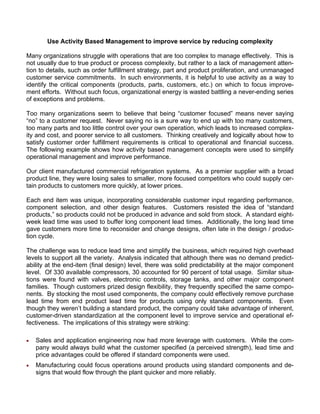
Activity Based Management
- 1. Use Activity Based Management to improve service by reducing complexity Many organizations struggle with operations that are too complex to manage effectively. This is not usually due to true product or process complexity, but rather to a lack of management atten- tion to details, such as order fulfillment strategy, part and product proliferation, and unmanaged customer service commitments. In such environments, it is helpful to use activity as a way to identify the critical components (products, parts, customers, etc.) on which to focus improve- ment efforts. Without such focus, organizational energy is wasted battling a never-ending series of exceptions and problems. Too many organizations seem to believe that being “customer focused” means never saying “no” to a customer request. Never saying no is a sure way to end up with too many customers, too many parts and too little control over your own operation, which leads to increased complex- ity and cost, and poorer service to all customers. Thinking creatively and logically about how to satisfy customer order fulfillment requirements is critical to operational and financial success. The following example shows how activity based management concepts were used to simplify operational management and improve performance. Our client manufactured commercial refrigeration systems. As a premier supplier with a broad product line, they were losing sales to smaller, more focused competitors who could supply cer- tain products to customers more quickly, at lower prices. Each end item was unique, incorporating considerable customer input regarding performance, component selection, and other design features. Customers resisted the idea of “standard products,” so products could not be produced in advance and sold from stock. A standard eight- week lead time was used to buffer long component lead times. Additionally, the long lead time gave customers more time to reconsider and change designs, often late in the design / produc- tion cycle. The challenge was to reduce lead time and simplify the business, which required high overhead levels to support all the variety. Analysis indicated that although there was no demand predict- ability at the end-item (final design) level, there was solid predictability at the major component level. Of 330 available compressors, 30 accounted for 90 percent of total usage. Similar situa- tions were found with valves, electronic controls, storage tanks, and other major component families. Though customers prized design flexibility, they frequently specified the same compo- nents. By stocking the most used components, the company could effectively remove purchase lead time from end product lead time for products using only standard components. Even though they weren’t building a standard product, the company could take advantage of inherent, customer-driven standardization at the component level to improve service and operational ef- fectiveness. The implications of this strategy were striking: Sales and application engineering now had more leverage with customers. While the com- pany would always build what the customer specified (a perceived strength), lead time and price advantages could be offered if standard components were used. Manufacturing could focus operations around products using standard components and de- signs that would flow through the plant quicker and more reliably.
- 2. Purchasing could negotiate price and delivery more accurately and aggressively with ven- dors once standard components were identified. New products could be designed using standard components to further increase standardi- zation. Component standardization, based on activity analysis, led to a broad range of changes in the business to capitalize on inherent activity concentration in component parts. These changes reduced operational complexity and cost by more clearly focusing on “standard component” products as a distinct family of products. Conclusions Activity-based management provides significant benefits: High activity products provide the logical place to focus improvement efforts related to ser- vice, cost, and inventory performance. High activity items are more predictable, making them excellent candidates for pull-based replenishment and other process improvement ac- tivities. Simplifying a large portion of business activity can free resources (people and equipment) to better serve the less predictable portion of the business, which typically requires more atten- tion. Activity-based improvements can be implemented incrementally; e.g., by component family, activity level, etc., providing a logical migration path for an organization. Activity-based management is common sense commonly applied. It is a powerful concept that can help integrate and focus improvement initiatives into a coherent, strategic improvement plan. Though many companies have some elements of this concept in place, a broad organiza- tional implementation yields the greatest results. Implementing activity based management is not usually complex, but it is difficult in most organizations because it contradicts the common wisdom and falls victim to the old trap that, “we never did it that way.” Strong leadership is es- sential to get it started and keep it going.